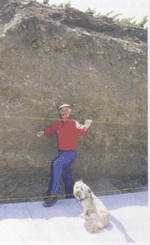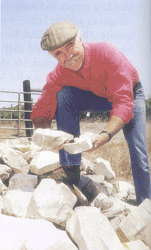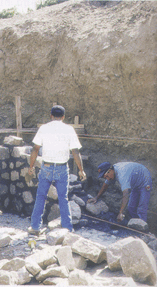


Talbott Winery
www.talbottvineyards.com
Tasting room information or to place retail orders:
Open Thursday through Monday, 11am-5pm.
53 West Carmel Valley Road
PO Box 449
Carmel Valley, CA 93924
Click here
for map
(831)659-3500 fax (831)659-3515
note:
The following was taken from a seminar presented by vintner Robb Talbott,
which was published in the holiday 2000 issue of "Adventures"
magazine.

A
Rocky Path to Great Wine
|
Both are located in the cool maritime-influenced climate of Monterey County and both slope from top to bottom at about the same angle, but they are quite different in perception. As growers of wines, we know that there is an interaction between the plant and its environment, sometimes known as terroir. Terroir refers to the earth, but also the seasons, rainfall, climate, winds, temperatures and even unknown forces that we have to struggle to understand. The concept has been around for centuries, simple and a bit primitive on one hand, but extremely complex on another. Basically it concerns the caretaker or grower working with the plant (in this case, the grapevine) long enough to recognize that all of these effects are felt in the final outcome, in the quality of the wine. We
use this information to try and grow the right plant, clones, variety,
in the right place, slope, facing, yet after all these years of
growing grapes at both Diamond T Estate home ranch and Sleepy Hollow
Vineyards, we still find that some vines thrive in certain areas
and others barely survive. These
vineyard are 30 miles apart by road. The 24 -acre Diamond T Estate
planting is only eight miles from Carmel Bay and faces South. The
Sleepy Hollow Vineyard sits 23 miles from Monterey Bay and faces
North. Both carry the overall Monterey County appellation with out
sleepy Hollow parcel located in the Stana Lucia Highlands appellation. Fruit from both vineyards is handled the same way in the winery. Both are hand-picked into 40-pound lugs at harvest. The crushing and pressing is done by the same machines, the juice settled and racked into French barrels of the same size. Hand enoculation follows using the same yeasts. The only difference is some extra aging for the Diamond T Estate wines. Yet they are incredibly different tasting wines. The Sleepy Hollow shows soft, tropical, apple citrus, earth, sweet yeast and vanilla oak, with a medium-plus fullness in the mouth. The Diamond T exhibits the essences of rich, soft, tropical fruit, yeast and subtle toast oak, with flavors of spice and nuts. It is a full, rich wine. The flavors of the two wines are very distinct and the difference easily discernable in the mouth. Sleepy
Hollow, planted in 1973, gives average yields of between two-and-a-half
to three tons per acre. The vineyards face North, sitting on a slight
slope of Arroyo Seco gravelly loam. It is alluvial (geologist term
for a type of sediment) in composition with the topsoil composed
of granular decomposed granite to about 24 -inches to 30 -inches.
Below that, our vineyard is a more typical slope-wash(rock that
washes down from the top of coarse pebbles, angular rock fragments
and much larger pieces of fractured granite and quartz. While
preparing the vineyard for planting, we used two D-8 tractors chained
together in order to pull a huge six-foot steel ripper that weighed
one ton. But when we got in front of the winery, the tractor lodged
in a giant piece of quartz and stopped dead. The boulder won, breaking
the ripper into two pieces! The ripper was sent off to the smelter
but we still have our five-ton quartz boulder at the entrance to
the winery! Needless to say, with this soil type our drainage is
wonderful; the vines never get wet feet. Our
Diamond T Estate vines were planted in 1984 close to Carmel Bay
where the yields rarely exceed one ton per acre. Harvest falls later
there than at Sleepy Hollow Vineyards, usually in October. Diamond
T fruit grows almost exclusively in Monterey shale mixed with smaller
rock fragments and loam. The topsoil ranges from four inches at
the top to 15 at the bottom, which is underlain by heavy layers
of fractured shale. Our sedimentary shale came from warm shallow
seas millions of years ago, giving our ranch amazing fossil beds.
All of our three children have brought their classmates up to the
ranch to enjoy this history. While
preparing the Diamond T Ranch for vineyard planting, our tractor
brought up so much rock we weren't quite sure what to do with it.
Our solution seemed quite simple. We couldn't haul it off so we
used sledgehammers to break it up into smaller pieces. But after
three months of back-breaking, 10-hour days smashing large rocks
into smaller ones, nine laborers walked off the job, I wanted to
join them, but for obvious reasons, couldn't. After
planting, we of course had to wait years with both vineyards before
we actually knew what we had in terms of grape quality. Do
we now have favorite areas that make better wine than others? You
bet, and the difference in quality is significant. Given that thousands
of years have eroded the geologic high points of our vineyards,
very little top soil remains up there. It obviously erodes down
the hill, some stopping on the mid-slope, most going all the way
down to the bottom. The mid-slope, known as the belly, concentrates
soil and nutrients, traps the sun and provides very good drainage.
This soil covers the slope-wash, which is composed of eroded material
from above. Below the belly, lays the toe or foot of the mountain,
where the soil is heavier and damper. Here the water table is higher
and doesn't drain as well. Remember that grapes don't like wet feet.
The vines are leafier and bushier and produce too much fruit. Fruit
that is watery and flabby. Not a good thing for quality wine. With
all of this in mind, it is fairly obvious that our favorite fruit
comes from the "belly" of both vineyards and our wines,
made from this mid-slope fruit, show more depth, complexity, roundness,
and just pain quality. This is one of the reasons all our barrels
are kept separate until the final blending is done. That way we
can declassify any that do not measure up, thereby keeping the quality
as high as possible. We find that declassification is one of our
best tools for keeping Talbott labels consistent. Knowledge
of terroir helps our understanding in making balanced wine. If I
could use only one word to describe what I strive for in Talbott
wines it would be balance. Balance can be applied to the terroir,
the harvest yields, the harvest sugars and even the taste of the
grape. With Mother Nature always unpredictable, balance is an ongoing
challenge. But then again, I think the challenge is a big part of
what keeps us all in this crazy business. |
|
(The heart of Silicon Valley - home of AMD, Intel,
National Semiconductor, 3COM, Yahoo, among many others)
Voice: 800-727-3844 Fax: 800-727-3851
Kitm@americanleasing.com







